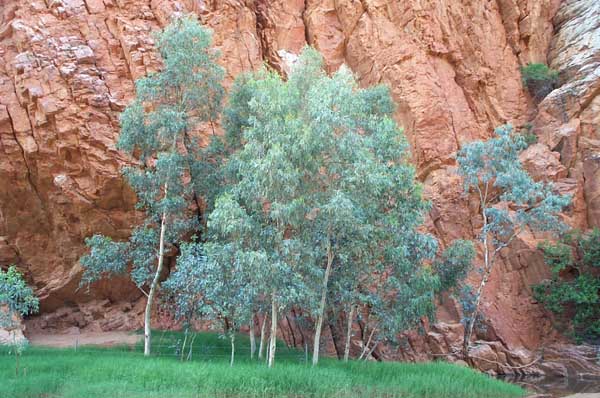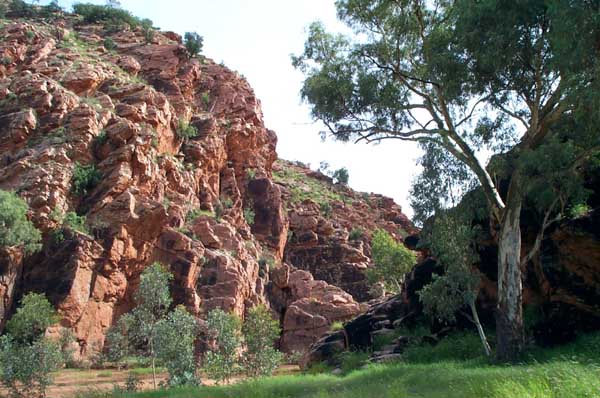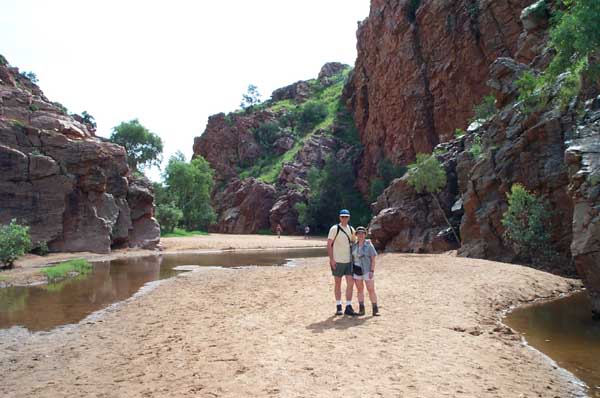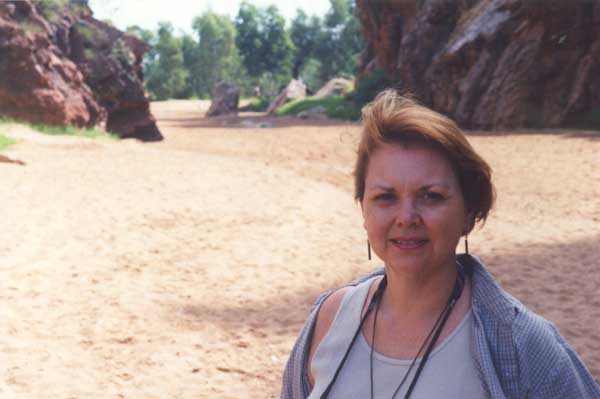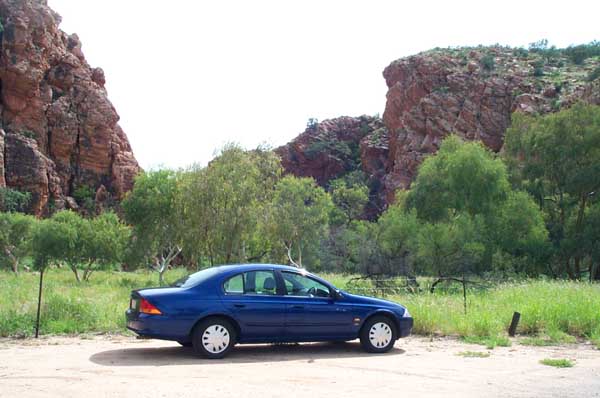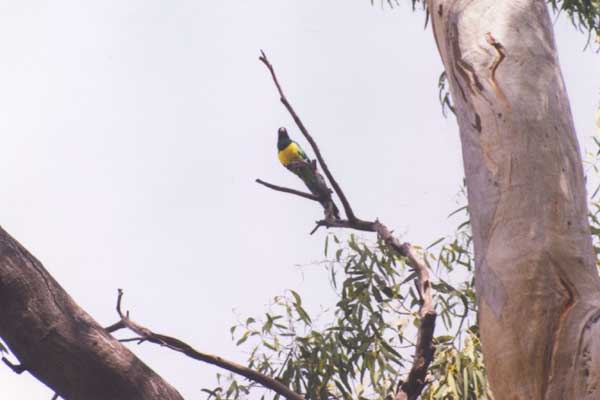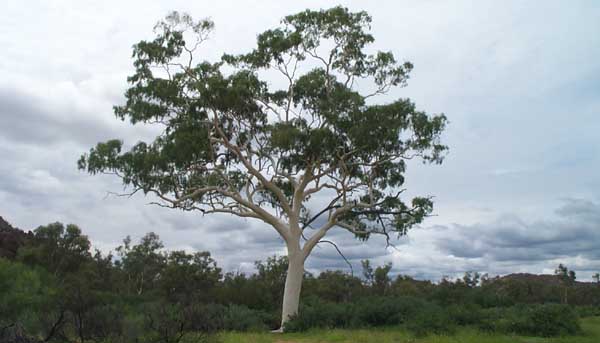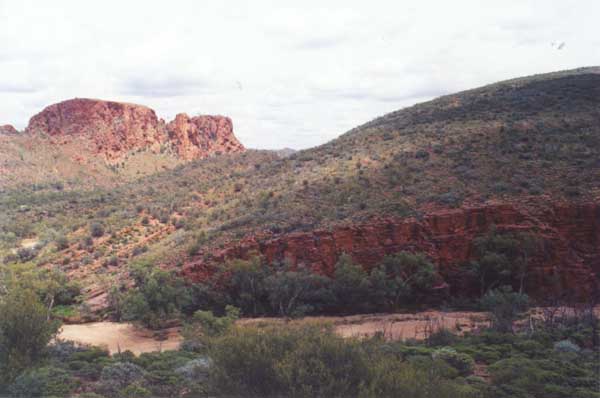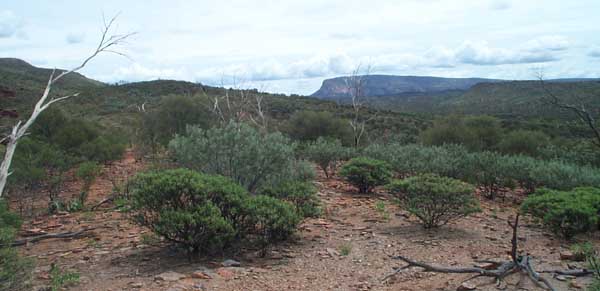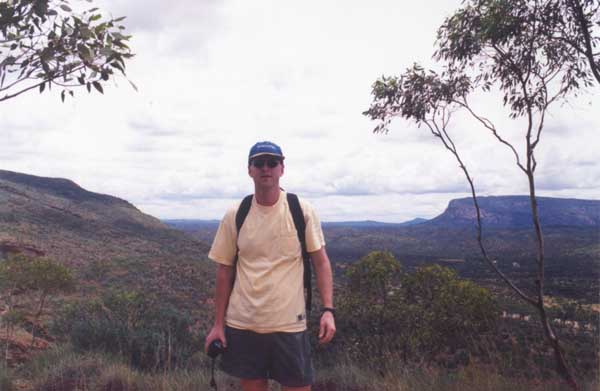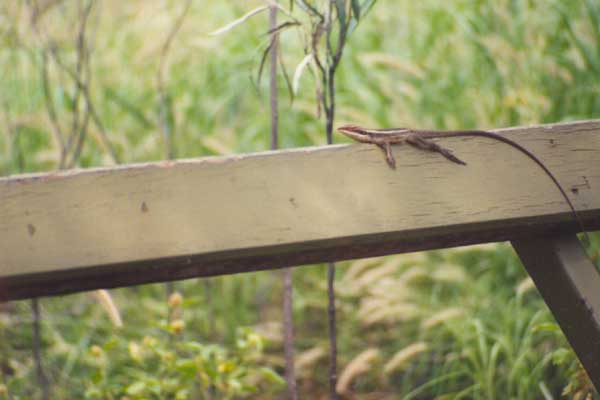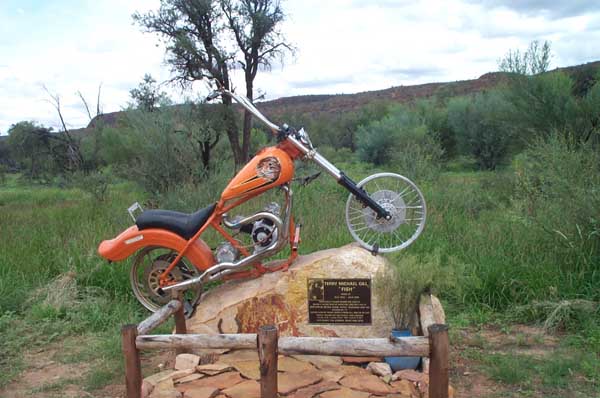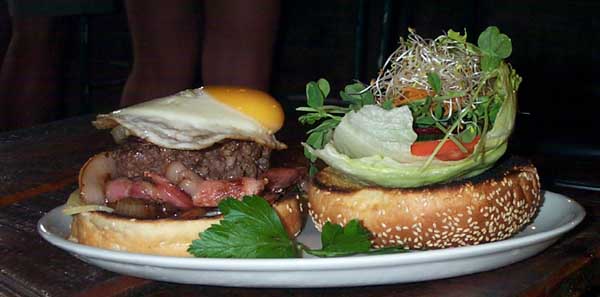We had a continental breakfast at the hotel, packed up our stuff, and headed out at 9:15. The plan for the day was to drive out east of Alice Springs into the Eastern MacDonnell Range, a low mountain range that runs from east to west, with part of it on one side of Alice and part on the other. We headed the wrong way out of the hotel, but the map showed the road we were on, Undoolya Road, meeting up with the road we wanted to be on, Ross Highway.
We crossed a couple of “grids”, bars set into the road to prevent cattle from escaping, and, after a couple of kilometers, the road turned from paved to dirt. Since the rental contract for our car forbids travel on unsealed roads, we turned around and headed back. As we got back into town on Undoolya Road, we saw several groups of Aboriginal women and children walking along the road. They were all barefoot and dressed in colorful skirts and tops.
We eventually made it back through town and down to the Ross Highway. It had been raining for two months in the Alice Springs area, more than the locals we talked to can remember. As a result, everything was growing and green. We expected red rocks and dirt, but we saw lush grass and trees everywhere we looked. Driving down Ross Highway, with its flat, straight path and the scrub plants growing on the plains reminded me of driving to the beach in North Carolina, except there were fewer pines along the road, and the “sand” was red.
Nearly every tree we saw was some sort of gum tree, the Australian name for eucalyptus trees. As we drove along the highway, we saw a sign that said “Beware. Traffic Hazards.” We didn’t see any hazards, but we did see a four-foot long lizard on the side of the road. As we approached, it disappeared into the grass. Shortly after the lizard, we saw two signs, one on each side of the road, that were simply a black circle with a line through it. There was nothing in the circle, so we didn’t know what it was prohibiting. Judging from the landscape around it, they could have meant “No where,” as in “Entering nowhere.” It wasn’t until a couple of days later that we would find out what the signs mean.
A short while later we arrived at Emily Gap, a place where a creek (usually dry) runs through the hills. We stopped there, and there were four other cars in the parking area. We explored the gap for about half an hour, and, as we headed back to the car, saw a couple taking pictures of each other. I offered to take a picture of the two of them with their camera, and they accepted. Then we asked them to take a picture of us with ours, which they did. As we all got back to the parking lot, the man said “See you at the next place.”
He was right, we were all headed in the same direction. The next place was Jessie Gap, much like Emily Gap, including the creek (usually dry). Every car that had been in the lot at Emily Gap ended up at Jessie Gap, too. We noticed a lot of flies buzzing around us, more than we had at Emily Gap. We spritzed ourselves with bug spray, and it may have helped, but we were still pestered by flies. As we walked in the dry creek bed though Jessie Gap, we could hear the flies buzzing, strange birds calling, and insects chattering. Somehow, all those noises made it seem more peaceful than silence would have. As we were heading back to the car, we saw a couple of the birds that were providing our sound track. One was a yellow, green, and black parrot. The other was a bright green bird that may have been a parrot, but probably wasn’t.
We got back in the car — air conditioning going full blast — and headed farther down Ross Highway. The next point of interest was Corroboree Rock, an aboriginal sacred site. There wasn’t much to see there. It was getting hot, and the flies were getting worse. After a short walk down the walking trail and back, we got into the car again, just as all of the other cars in our “tour group” were arriving.
About that time the highway narrowed to a single paved lane with dirt track on both sides. If we met a car coming from the other direction, we were supposed to slow down and drive with one set of wheels on the dirt while we passed. I can see why they didn’t bother with two lanes. During our entire drive, we passed only one car coming from the other direction.
We drove for quite a while without seeing any places to stop and walk around. We did pass through some areas that seemed more like swamp than desert. There were low trees, tall grass, and standing water in serveral spots. All of the lush greenery contrasted with the rocks, which, according to Chris, were of a “burnt sienna” color. We eventually came to a hiking spot called Trephina Gorge. There, the Trephina Creek (usually dry) “flows” between tall rock outcroppings. The trail heads are about 10km off the main road, and most of that drive is dirt. We threw caution to the wind and decided the rental car could handle it.
The road was rocky, but fairly smooth — nothing our trusty Falcon couldn’t handle. We stopped at an information kiosk and read about Trephina Gorge. We decided which trail to take, and headed off again. Before we got to the trail heads, there was a turn-out for the Ghost Gum, a white eucalyptus that is the largest known specimen of its species. We stopped and took a picture of a very large eucalyptus tree with bright white bark on the trunk and limbs, then got back into the car to find a place to turn around and go back to the road to the gorge. Fifty yards farther up the side road, we saw the real Ghost Gum, a beautiful tree twice the size of the one we had mistaken for it. We took another picture, turned around, and headed on.
We pulled into the parking lot at the trail head just ahead of the couple who had taken our picture for us at Emily Gap. We filled our water bottles — this was the first drinking water supply we had seen that morning — and started for the trail. The camera couple were starting out at the same time. We introduced ourselves, found out their names are Kim and Tracy, and headed on. After a short distance, the trail we were taking split from the one Kim and Tracy took. They were heading up one side of the gorge and we were heading up the other. It was just after noon.
As we walked, the flies became thicker and thicker. We walked along, and up, giving the Australian salute (see 5-March journal for details) every couple of seconds. At one point we could clearly see Kim and Tracy on the other side of the gorge, and Chris shouted a hello. They shouted back. While they were standing on the edge of the gorge, I got a picture of them with my zoom lens, getting a pretty clear picture. We decided to get their address so we could send it to them when it was printed. It got hotter, the climb got steeper, and the flies got more annoying. We were thinking about turning around, but I wanted to at least get to the top of the rise we were climbing. The trail was called Panorama Trail, and I wanted to see the panorama. Chris reluctantly agreed to keep fighting the flies and the heat with me.
We made it to the top of the gorge at about 12:30, and the view was worth the effort. We could see far-off parts of the Eastern MacDonnell range all around us.
The trail continued down the other side of the ridge, and was pretty easy walking. If it hadn’t been for the flies, it would have been very pleasant. At least until we walked into the spider web. I was walking behind Chris, fanning flies out of my face, when she suddenly said “Ick,” and stopped, leaning forward from the waist. I kept walking forward, then said “Ick,” and bent over myself. We had just walked into a very large, sticky, hard-to-see web. The spider was off to the side of the trail — not liking us very much, I’ll bet — but we both had large swatches of web on our faces.
After we cleaned off the web, we continued on. Chris got an idea. She was wearing a thin cotton shirt over her tank top. She took off the overshirt and started constantly fanning it in front of her face. She looked silly, but she said the flies weren’t bothering her any more. After watching her for a while, I decided to give it a try. I took off my cap and fanned it in front of my face. It worked. The flies didn’t come near my face.
As we reached the point where our trail joined with Kim and Tracy’s, we saw them coming back. We got their address and promised to send the pictures. We walked the rest of the way to the parking lot with them. When we were almost back to the cars, we saw a lizard resting on a bench, and took a picture. Kim made Tracy sit next to it while he took a picture of them both.
We drove the 10km back to the Ross Highway and headed farther east. At one point we passed a rock with a banged-up and stripped Harley-Davidson motorcycle mounted to it with metal bands. I stopped and went back to see what it was about.
According to the plaque on the rock, it is a memorial to a motorcyclist named Terry Michael Gill, whose nickname was “Fish”. He crashed his motorcycle and died on that spot on 23 August 1998. In addition to the memorial rock is a post that has a bag for messages to Fish. It’s crammed full of notes.
Not far past the Fish Memorial we came to the end of the highway. The paved road ends at a place called Ross River Homestead. It is a farm that also has cottages and rooms for rent. There are camels and horses for riding, as well as a restaurant. We looked the camels over, decided not to ride them, said goodbye to Kim and Tracy — who were just leaving — and went into the restaurant. It is rustic, but it was cooler than outdoors, and there weren’t nearly as many flies.
We looked over the menu and both decided on a burger. I ordered mine plain, but Chris ordered “The Lot,” which was listed on the menu just that way, with no explanation. When the burgers came, we found out that “plain” included the five-inch diameter bun, a 1/2 pound ground sirloin burger, and a salad: lettuce, beets, carrots, zucchini, and watercress. The salad isn’t in a bowl, it’s perched on the top half of the bun and meant to be eaten with the burger. “The Lot” has all that and a few other things on it: cheese, grilled onions, bacon, pineapple, and a fried egg, sunny side up. Chris and I traded burgers, but I gave her my salad.

Over the bar in the Ross Homestead is a large collection of currency from many different countries. There is also a sign that has a string of capital letters on it. It says:
ISDERASMNEORSSEDSASDERISORSSRSS?
We figured it out during lunch. We walked around a little bit more after lunch then started back toward Alice Springs around 2:45pm. The drive back was about an hour, compared to the four hours it took us to drive out with all of the stops and hikes.
I had a couple of rolls of film to process, so I drove them into town to a one-hour processing store. I got there around 4:20, and it closed at 5:30, but they said they could get the film done. I then drove back to the hotel where we got cleaned up and dressed for dinner. We had 6:30 reservations at the Overlander Steakhouse, reported to be the place locals take out-of-town guests. We left for the restaurant early so we could pick up the photos. I went to get them while Chris window shopped. The pictures were ready when I got to the store, just about an hour after I dropped them off.
We still had some time before our reservation, so we looked at a couple of other stores, including one called “On Safari” where we saw hats with fly nets. We decided to buy ourselves a fly net the next day when we were back in town. We also went into an art gallery that specializes in Aboriginal art. Two of the pieces we saw really caught our eyes. We asked the salesman to hold them for us until the next day, when we could take our time and decide which one we had to have. He was perfectly willing to hold them until noon the next day.
We then walked to Overlander where our reservation had been misplaced. The man at the desk remembered taking the reservation, though, and getting a table was no problem. Overlander is known for its Australian bush fare, including kangaroo meat, crocodile, emu, camel, and baramundi, a local fish. We started with Crocodile Vol au Vent, crocodile meat, cream sauce and a pastry. For our main course, Chris chose the baramundi, and I opted for kangaroo fillet. Everything was delicious. Kangaroo tastes a lot like venison. Crocodile has a delicate flavor that is very pleasant. The baramundi is a light fish with a delicate flavor a bit like orange roughy. Everyone at the Overlander gets a flag for their table that shows where they are from. We saw several American flags, a British Union Jack, a Swiss flag, and one Northern Territories flag for a local.
After dinner we drove back to the hotel for an early bed time. The next day, we had to get up at 4:30 for our balloon ride.
